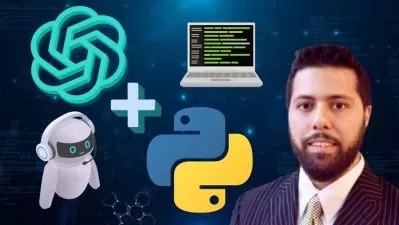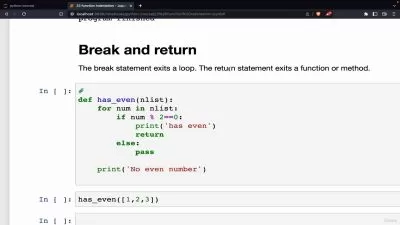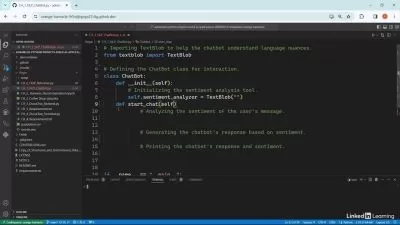Mastering SVM: A Comprehensive Guide with Code in Python
Hoang Quy La
3:37:25
Description
V-Support vector machine, slack variables, Support Vector Regression (SVR), Kernel Trick
What You'll Learn?
- Maximum margin
- slack variables
- Data preprocessing
- Standardizing features
- Overfitting
- Train the model
- Kernel Trick
- C parameter in support vector machine
- Linear Classification in SVM
- Non-linear SVM implementation
- V-Support vector machine
- Support Vector Regression (SVR)
- Confusion matrix
- Splitting the datasets into training and testing sets
Who is this for?
What You Need to Know?
More details
DescriptionUnleashing the Power of Support Vector Machine
What is Support Vector Machine?
SVM is a supervised machine learning algorithm that classifies data by creating a hyperplane in a high-dimensional space. It is widely used for both regression and classification tasks. SVM excels at handling complex datasets, making it a go-to choice for various applications, including image classification, text analysis, and anomaly detection.
The Working Principle of SVM
At its core, SVM aims to find an optimal hyperplane that maximally separates data points into distinct classes. By transforming the input data into a higher-dimensional feature space, SVM facilitates effective separation, even when the data is not linearly separable. The algorithm achieves this by finding support vectors, which are the data points closest to the hyperplane.
Key Advantages of Support Vector Machine
Flexibility: SVM offers versatile kernel functions that allow nonlinear decision boundaries, giving it an edge over other algorithms.
Robustness: SVM effectively handles datasets with outliers and noise, thanks to its ability to focus on the support vectors rather than considering the entire dataset.
Generalization: SVM demonstrates excellent generalization capabilities, enabling accurate predictions on unseen data.
Memory Efficiency: Unlike some other machine learning algorithms, SVM only requires a subset of training samples for decision-making, making it memory-efficient.
The Importance of Maximum Margin
By maximizing the margin, SVM promotes better generalization and robustness of the classification model. A larger margin allows for better separation between classes, reducing the risk of misclassification and improving the model's ability to handle unseen data. The concept of maximum margin classification is rooted in the idea of finding the decision boundary with the highest confidence.
Use Cases of SVM
SVM finds its applications in a wide range of domains, including:
Image Recognition: SVM's ability to classify images based on complex features makes it invaluable in computer vision tasks, such as facial recognition and object detection.
Text Classification: SVM can classify text documents, making it ideal for sentiment analysis, spam detection, and topic categorization.
Bioinformatics: SVM aids in protein structure prediction, gene expression analysis, and disease classification, contributing significantly to the field of bioinformatics.
Finance: SVM assists in credit scoring, stock market forecasting, and fraud detection, helping financial institutions make informed decisions.
Best Practices for SVM Implementation
To maximize the effectiveness of SVM in your projects, consider the following best practices:
Data Preprocessing: Ensure your data is properly preprocessed by performing tasks such as feature scaling, handling missing values, and encoding categorical variables.
Hyperparameter Tuning: Experiment with different kernel functions, regularization parameters, and other hyperparameters to optimize the performance of your SVM model.
Feature Selection: Select relevant features to improve SVM's efficiency and avoid overfitting.
Cross-Validation: Utilize cross-validation techniques to validate your SVM model and assess its generalization capabilities.
Kernel Trick
The SVM algorithm utilizes the "kernel trick" technique to transform the input data into a higher-dimensional feature space. This transformation allows nonlinear decision boundaries to be defined in the original input space. The kernel function plays a vital role in this process, as it measures the similarity between pairs of data points. Commonly used kernel functions include the linear kernel, polynomial kernel, and radial basis function (RBF) kernel.
Margin and Support Vectors
In SVM, the margin refers to the region between the decision boundary (hyperplane) and the nearest data points from each class. The goal is to find the hyperplane that maximizes this margin. The data points that lie on the margin or within a certain distance from it are known as support vectors. These support vectors are critical in defining the hyperplane and determining the classification boundaries.
C-Parameter and Regularization
The C-parameter, often called the regularization parameter, is a crucial parameter in SVM. It controls the trade-off between maximizing the margin and minimizing the classification errors. A higher value of C places more emphasis on classifying data points correctly, potentially leading to a narrower margin. On the other hand, a lower value of C allows for a wider margin but may result in more misclassifications. Proper tuning of the C-parameter is essential to achieve the desired balance between model simplicity and accuracy.
Nonlinear Classification with SVM
One of the major strengths of SVM is its ability to handle nonlinear classification problems. The kernel trick allows SVM to map the input data into a higher-dimensional space where linear separation is possible. This enables SVM to solve complex classification tasks that cannot be accurately separated by a linear hyperplane in the original feature space.
SVM Training and Optimization
The training of an SVM model involves finding the optimal hyperplane that maximizes the margin and separates the classes. This optimization problem can be formulated as a quadratic programming task. Various optimization algorithms, such as Sequential Minimal Optimization (SMO), are commonly used to solve this problem efficiently.
Conclusion
Support Vector Machine is a versatile and robust algorithm that empowers data scientists to tackle complex classification and regression problems. By harness
Who this course is for:
- Anyone interested in Machine Learning.
- Students who have at least high school knowledge in math and who want to start learning Machine Learning, Deep Learning, and Artificial Intelligence
- Any people who are not that comfortable with coding but who are interested in Machine Learning, Deep Learning, Artificial Intelligence and want to apply it easily on datasets.
- Any students in college who want to start a career in Data Science
- Any people who want to create added value to their business by using powerful Machine Learning, Artificial Intelligence and Deep Learning tools. Any people who want to work in a Car company as a Data Scientist, Machine Learning, Deep Learning and Artificial Intelligence engineer.
Unleashing the Power of Support Vector Machine
What is Support Vector Machine?
SVM is a supervised machine learning algorithm that classifies data by creating a hyperplane in a high-dimensional space. It is widely used for both regression and classification tasks. SVM excels at handling complex datasets, making it a go-to choice for various applications, including image classification, text analysis, and anomaly detection.
The Working Principle of SVM
At its core, SVM aims to find an optimal hyperplane that maximally separates data points into distinct classes. By transforming the input data into a higher-dimensional feature space, SVM facilitates effective separation, even when the data is not linearly separable. The algorithm achieves this by finding support vectors, which are the data points closest to the hyperplane.
Key Advantages of Support Vector Machine
Flexibility: SVM offers versatile kernel functions that allow nonlinear decision boundaries, giving it an edge over other algorithms.
Robustness: SVM effectively handles datasets with outliers and noise, thanks to its ability to focus on the support vectors rather than considering the entire dataset.
Generalization: SVM demonstrates excellent generalization capabilities, enabling accurate predictions on unseen data.
Memory Efficiency: Unlike some other machine learning algorithms, SVM only requires a subset of training samples for decision-making, making it memory-efficient.
The Importance of Maximum Margin
By maximizing the margin, SVM promotes better generalization and robustness of the classification model. A larger margin allows for better separation between classes, reducing the risk of misclassification and improving the model's ability to handle unseen data. The concept of maximum margin classification is rooted in the idea of finding the decision boundary with the highest confidence.
Use Cases of SVM
SVM finds its applications in a wide range of domains, including:
Image Recognition: SVM's ability to classify images based on complex features makes it invaluable in computer vision tasks, such as facial recognition and object detection.
Text Classification: SVM can classify text documents, making it ideal for sentiment analysis, spam detection, and topic categorization.
Bioinformatics: SVM aids in protein structure prediction, gene expression analysis, and disease classification, contributing significantly to the field of bioinformatics.
Finance: SVM assists in credit scoring, stock market forecasting, and fraud detection, helping financial institutions make informed decisions.
Best Practices for SVM Implementation
To maximize the effectiveness of SVM in your projects, consider the following best practices:
Data Preprocessing: Ensure your data is properly preprocessed by performing tasks such as feature scaling, handling missing values, and encoding categorical variables.
Hyperparameter Tuning: Experiment with different kernel functions, regularization parameters, and other hyperparameters to optimize the performance of your SVM model.
Feature Selection: Select relevant features to improve SVM's efficiency and avoid overfitting.
Cross-Validation: Utilize cross-validation techniques to validate your SVM model and assess its generalization capabilities.
Kernel Trick
The SVM algorithm utilizes the "kernel trick" technique to transform the input data into a higher-dimensional feature space. This transformation allows nonlinear decision boundaries to be defined in the original input space. The kernel function plays a vital role in this process, as it measures the similarity between pairs of data points. Commonly used kernel functions include the linear kernel, polynomial kernel, and radial basis function (RBF) kernel.
Margin and Support Vectors
In SVM, the margin refers to the region between the decision boundary (hyperplane) and the nearest data points from each class. The goal is to find the hyperplane that maximizes this margin. The data points that lie on the margin or within a certain distance from it are known as support vectors. These support vectors are critical in defining the hyperplane and determining the classification boundaries.
C-Parameter and Regularization
The C-parameter, often called the regularization parameter, is a crucial parameter in SVM. It controls the trade-off between maximizing the margin and minimizing the classification errors. A higher value of C places more emphasis on classifying data points correctly, potentially leading to a narrower margin. On the other hand, a lower value of C allows for a wider margin but may result in more misclassifications. Proper tuning of the C-parameter is essential to achieve the desired balance between model simplicity and accuracy.
Nonlinear Classification with SVM
One of the major strengths of SVM is its ability to handle nonlinear classification problems. The kernel trick allows SVM to map the input data into a higher-dimensional space where linear separation is possible. This enables SVM to solve complex classification tasks that cannot be accurately separated by a linear hyperplane in the original feature space.
SVM Training and Optimization
The training of an SVM model involves finding the optimal hyperplane that maximizes the margin and separates the classes. This optimization problem can be formulated as a quadratic programming task. Various optimization algorithms, such as Sequential Minimal Optimization (SMO), are commonly used to solve this problem efficiently.
Conclusion
Support Vector Machine is a versatile and robust algorithm that empowers data scientists to tackle complex classification and regression problems. By harness
Who this course is for:
- Anyone interested in Machine Learning.
- Students who have at least high school knowledge in math and who want to start learning Machine Learning, Deep Learning, and Artificial Intelligence
- Any people who are not that comfortable with coding but who are interested in Machine Learning, Deep Learning, Artificial Intelligence and want to apply it easily on datasets.
- Any students in college who want to start a career in Data Science
- Any people who want to create added value to their business by using powerful Machine Learning, Artificial Intelligence and Deep Learning tools. Any people who want to work in a Car company as a Data Scientist, Machine Learning, Deep Learning and Artificial Intelligence engineer.
User Reviews
Rating
Hoang Quy La
Instructor's Courses
Udemy
View courses Udemy- language english
- Training sessions 28
- duration 3:37:25
- Release Date 2023/07/31














